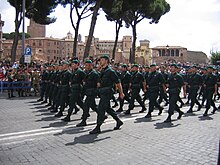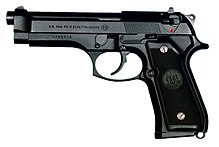Comando Subacquei ed Incursori
The Comando Subacquei ed Incursori (COMSUBIN) (also Raggruppamento Subacquei ed Incursori "Teseo Tesei" ) is a special unit of the Italian Navy . It consists of divers and commandos . COMSUBIN is based in the Varignano fortress near La Spezia .
assignment
The Comando Subacquei ed Incursori can be used as a naval , airborne and ground special unit. The range of applications includes:
- Counterterrorism
- Asymmetrical warfare
- Covert operations
- Remote reconnaissance
- Attacks on warships in enemy ports
- Fight against individual targets on land (especially headquarters and telecommunications facilities)
- Evacuation, rescue and rescue operations
- Defense against attacks on the high seas
organization
COMSUBIN consists of around 700 soldiers and civilian employees. Many matters are still subject to confidentiality.
Gruppo Operativo Incursori (GOI)
GOI is the name of the frogman unit of COMSUBIN . It consists of 150 to 200 specially trained soldiers. The tasks include sweeping acts of sabotage against sea and coastal targets, the occupation of ships and oil rigs and other counter-terrorism operations. The members of this unit can be recognized by their green berets , on which there is an emblem with a crossed sword and anchor .
Gruppo Operativo Subaquei (GOS)
GOS is the name of the mine clearance diver unit of COMSUBIN . The special tasks include the disposal of ordnance and rescue operations at great depths (with special equipment up to 300 m). Rescue teams and special underwater vehicles for possible accidents (eg. Submarine - accident ) kept in constant readiness. This unit has no offensive tasks.
Gruppo Navale Speciale (GNS)
This unit maintains all for COMSUBIN immediately necessary marine vessels , including the submarine rescue ship Anteo (A 5309), support boats for Kampfschwimmer Angelo Cabrini (P 420) and Tuillio Tedeschi (P 421), and a plurality of smaller boats .
Gruppo Scuole
The training group offers a wide range of courses, including for members of other Italian and foreign special units . The focus here is on amphibious operations. COMSUBIN commandos also complete courses at airborne and winter combat schools as part of their two-year training. Training phases in the tropics and other extreme climates are also planned.
Gruppo Logistico
The logistic group takes on tasks in the areas of replenishment, supply, material maintenance and medical services.
Study Office
This office observes and examines the latest developments in military technology. It procures and tests various types of material and develops and tests new application modalities.
Recruitment and training
Applicants must not be older than 27 years and must already belong to the Navy. The approximately one-year basic training in the training group begins with a two-week trial training course in which medical examinations are carried out and the applicants' mental and physical performance is tested. This is followed by twelve-week combat training on land, which is also used for physical training, 13 weeks of training in the water, twelve weeks of amphibious combat training and a final 15-week section in which operations are practiced under realistic conditions. The training content includes hand-to-hand combat , house-to-house combat , killing from ambush , counter-terrorism , light weapons, heavy weapons, sabotage , mine clearance , technical communication , reconnaissance and intelligence gathering, and survival in difficult situations. If all training sections have been passed, a six-month specialization course follows, which deepens one of the skills. Then the applicant has achieved test subject status. This means that he will now be assigned to an active unit in order to complete his training in practice. After about two years of training and practical training, the aspirant finally receives his full operational status and the green COMSUBIN beret .
equipment
Below is a selection of the most important pieces of equipment:
- Beretta 92SB-FS ( 9 mm pistol )
- M4 (assault rifle) (with M203 (grenade launcher) )
- HK MP5 ( submachine gun in different versions)
- FN Minimi (light machine gun 5.56 mm)
- M60 machine gun (M60E3 7.62mm)
- Sniper rifles, rocket launchers, mines
history
The use of small arms and combat swimmers has a long tradition in the Italian navy (the naval diving school was founded in Genoa on July 24, 1849). During the Second World War , the special forces of the Navy operated under the code name Xª Flottiglia MAS (10th Schnellbootflotille). From June 1940 to September 1943, this association was responsible for the sinking or serious damage to military ship units in the amount of 72,190 tons. In addition, there were 130,572 tons of civil shipping space. Among the victims of Italian combat swimmers were the British battleships HMS Queen Elizabeth and HMS Valiant , the heavy cruiser HMS York , the destroyers HMS Jervis and HMS Eridge , and over 20 merchant ships. The two above Battleships were u. a. the aim of a mission carried out in December 1941 by Luigi Durand de la Penne and five other combat swimmers as torpedo riders in the port of Alexandria . There were other missions of this or a similar type in Malta (here the combat swimmer and naval officer Teseo Tesei was killed on July 26, 1941 during the Operazione Malta Due ), in Gibraltar ("Gamma" special unit from the tanker Olterra in Algeciras ) and in Crete (HMS York ). In the Black Sea , Italian special marine units operated against Soviet bases in Sevastopol and Balaklava . In the vicinity of Yalta they sank u. a. two Soviet submarines ( S 32 and SHCH 306 ).
The armistice of September 8, 1943 led to a traumatic split in the Xª Flottiglia MAS . In the special unit, which under Junio Valerio Borghese fought for the fascist Repubblica Sociale Italiana and for the Germans, concentrated fascists who were to play a role in Italian politics even after the war. At the same time, a special unit operating under Allied control was established in Taranto , which carried out a number of attacks on northern Italian ports (including the severe damage to the almost finished Italian aircraft carrier Aquila ). After the war , the Allies in Italy banned the maintenance of combat swimmers and the associated small weapons, but for years they secretly maintained a combat swimmer school in Venice , which essentially continued to work in accordance with the tried and tested earlier training guidelines. The former members of the disbanded special forces operated under the name "Marinetaucher" for a transitional period and did valuable work in the years after the war in mine clearance , the lifting of shipwrecks and the disposal of all other war-related contaminated sites in Italian ports.
After the military restriction clauses were repealed , the combat swimmers' school was moved from Venice to La Spezia (Varignano) and in 1952 a special naval unit was officially founded again, which in 1960 was officially named Raggruppamento Subaquei e Incursori "Teseo Tesei" . Traditions and all awards of the Xª Flottiglia MAS went to her . In addition, this unit also operated under the name COMSUBIN (to this day in the coat of arms), which has established itself both within the Navy and in general linguistic usage.
Members of COMSUBIN took part in all foreign missions of the Italian army , including the peace mission in Lebanon (1982–1984), a mine clearance mission in the Red Sea (1984), and an evacuation of civilians in Rwanda (1994, NEO-Noncombatant Evacuation Operation , together with special army units), as well as on the international missions in Somalia , the Balkans , East Timor , Afghanistan , Iraq etc.
COMSUBIN is directly subordinate to the Admiral's Chief of Staff , and the "Command for Special Operations" ( COFS ) of the General Staff of the Armed Forces is responsible for the operations.
References
See also
literature
- Luca Poggiali: Una leggenda fra le onde. Gruppo Operativo Incursori. Editoriale Lupo, Vicchio 2006.
- Sören Sünkler: Europe's elite and special units. Motorbuch-Verlag, Stuttgart 2008, ISBN 978-3-613-02853-1 .
Web links
Footnotes
- ↑ ARS Anteo (A 5309). In: marina.difesa.it. Retrieved March 3, 2020 (Italian).
- ↑ INTERMARINE (Gruppo IMMSI): consegnata alla Marina Militare Italiana l'UNPAV Tullio Tedeschi. In: difesaonline.it. March 3, 2020, accessed March 3, 2020 (Italian).
Coordinates: 44 ° 4 ′ N , 9 ° 51 ′ E


